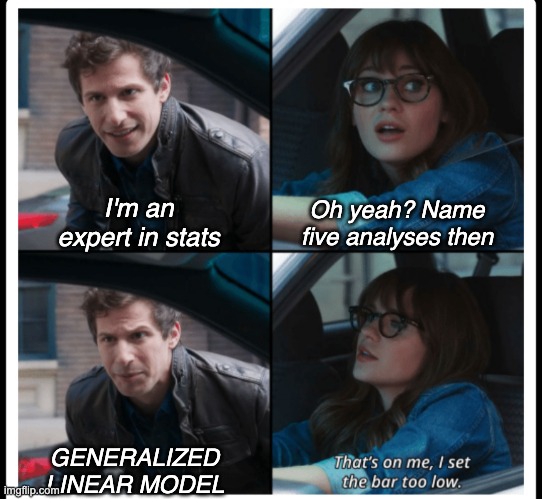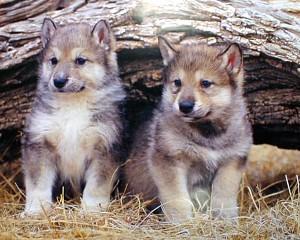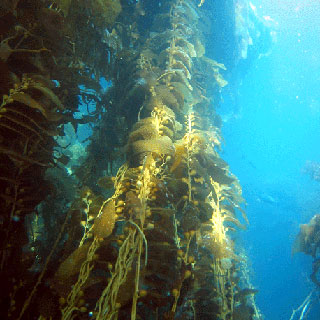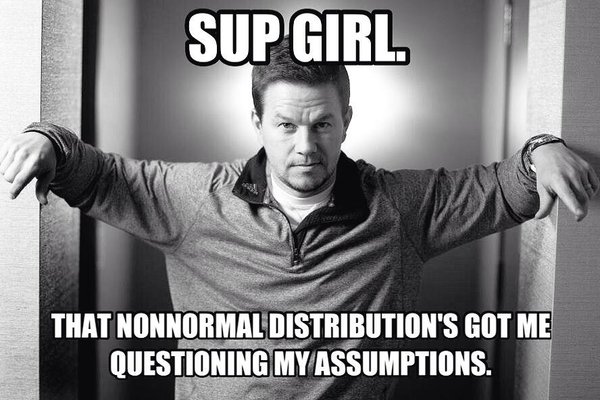class: center, middle # Generalized Linear Models and Overdispersion  <style type="text/css"> .pull-left-small { float: left; width: 20%; } .pull-right-large { float: right; width: 80%; } </style> --- # A Generalized Linear World 1. How do we fit this: Likelihood 2. Count Data and GLMs 3. Overdispersion --- class: middle, left # Likelihood: how well data support a given hypothesis. -- <br><br><br> ### Note: Each and every parameter choice IS a hypothesis</span></h4> --- ## Likelihood Defined <br><br> `$$\Large L(H | D) = p(D | H)$$` Where the D is the data and H is the hypothesis (model) including a both a data generating process with some choice of parameters (often called `\(\theta\)`). The error generating process is inherent in the choice of probability distribution used for calculation. --- ## Example of Maximum Likelihood Fit Let’s say we have counted 10 individuals in a plot. Given that the population is Poisson distributed, what is the value of `\(\lambda\)`? <div id = "left" style="width:60%"> <img src="glm_overdispersion_files/figure-html/likelihoodSapply-1.png" style="display: block; margin: auto;" /> </div> <div id="right", style="width:40%"> <br><br> `$$p(x) = \frac{\lambda^{x}e^{-\lambda}}{x!}$$` <br>where we search all possible values of λ </div> --- ## Likelihood Function `$$\Large p(x) = \frac{\lambda^{x}e^{-\lambda}}{x!}$$` <br><br> - This is a **Likelihood Function** for one sample - It is the Poisson Probability Density function -- - `\(Dpois = \frac{\lambda^{x}e^{-\lambda}}{x!}\)` --- ## What is the probability of many data points given a parameter? <div id="left", style="width:60%"> <img src="glm_overdispersion_files/figure-html/likelihoodDemo2-1.png" style="display: block; margin: auto;" /> </div> <div id="right", style="width:40%"> <br><br> p(a and b) = p(a)p(b) <br><br><br> `$$p(D | \theta) = \prod_{i=1}^n p(d_{i} | \theta)$$` <br><br> <span class="fragment">$$ = \prod_{i=1}^n \frac{\theta^{x_i}e^{-\theta}}{x_!}$$</span> </div> --- ## Can Compare p(data | H) for alternate Parameter Values <img src="glm_overdispersion_files/figure-html/likelihoodDemo3-1.png" style="display: block; margin: auto;" /> Compare `\(p(D|\theta_{1})\)` versus `\(p(D|\theta_{2})\)`, choose the one with higher likelihood --- # In Practice We Use Log-Likelihood Surfaces for Computation and Shape to find the Maximum Likelihood ## (Or Really, Deviance, -2 LL, for optimization) <img src="glm_overdispersion_files/figure-html/likelihoodSapply1Plot-1.png" style="display: block; margin: auto;" /> <!-- Maximum Likelihood: 1.3319144\times 10^{-11} at 17 Maximum Log Likelihood: -25.0418188 at 17 Deviance: 50.0836375 --> --- ## Optimizing over Multiple Parameters get's Harder <img src="glm_overdispersion_files/figure-html/mleSurfPersp-1.png" style="display: block; margin: auto;" /> Want to find the Maximum Likelihood (or minimum Deviance) to get the MLE (Maximum Likelihood Estimate) of parameters --- ## Contour Plot of a Likelihood Surface <img src="glm_overdispersion_files/figure-html/contour_LL-1.png" style="display: block; margin: auto;" /> <p align="left"> MLEs: mean = 3730.05, SD = 1293.4 </p> --- ## Issues with Likelihood and Models 1. What Values Are Used for 95% CI? 2. Grid Sampling Becomes Slow 3. Algorithmic Solutions Necessary 4. Specification of Likelihood Function Unwieldy --- ## Likelihood Profile of One Coefficient Along ML Estimates of the Other <font color="red">Mean profile</font>, <font color="blue">SD Profile</font> <img src="glm_overdispersion_files/figure-html/profileBrute4-1.png" style="display: block; margin: auto;" /> --- ## Then Use Likelihood Profiles to get CIs (more on this later) <img src="glm_overdispersion_files/figure-html/mleWolvesMeanProfile-1.png" style="display: block; margin: auto;" /> ``` 2.5 % 97.5 % mean 3704.364 3756.122 sd 1275.384 1311.887 ``` --- ## How Do We Search Multiparameter Likelihood Space? We use <span style="color:red">Algorithms</span> - Newtown-Raphson (algorithmicly implemented in <span>nlm</span> and <span>BFGS</span> method) uses derivatives - good for smooth surfaces & good start values -- - Nelder-Mead Simplex (<span>optim</span>’s default) - good for rougher surfaces, but slower -- - Simulated Annealing (<span>SANN</span>) uses Metropolis Algorithm search - global solution, but slow -- - For GLMs, we use **Iteratively Reweighted Lease Squares** - fast - specific to models from the exponential family --- # A Generalized Linear World 1. How do we fit this: Likelihood 2. .red[Count Data and GLMs] 3. Overdispersion --- # Remember our Wolves? .pull-left[ <img src="glm_overdispersion_files/figure-html/wolf_scatterplot-1.png" style="display: block; margin: auto;" /> ] .pull-right[ <br><br>  ] --- # We Had to Log Transform The Count of Pups `$$log(y_i) = \beta_0 + \beta_1 x_i + \epsilon_i$$` - using count data - relationship is curved - cannot have negative pups <img src="glm_overdispersion_files/figure-html/logplot-1.png" style="display: block; margin: auto;" /> --- # But...  -- Note, there is a healthy back-and-forth about this paper in the literature... but I think it has some REALLY good points --- # Why? Count Data is Discrete - so we need an appropriate distribution ### Enter the Poisson! In a Poisson, Variance = Mean <img src="glm_overdispersion_files/figure-html/unnamed-chunk-2-1.png" style="display: block; margin: auto;" /> --- # The Poisson Generalized Linear Model with its Canonical Link $$\Large \boldsymbol{\eta_{i}} = \boldsymbol{\beta X_i} $$ <br><br> `$$\Large log(\hat{Y_i}) = \eta_{i}$$` <br><br> `$$\Large Y_i \sim \mathcal{P}(\hat{Y_i})$$` --- # Wait - isn't this just a log transform? -- No. -- `$$\Large \boldsymbol{log(Y_{i})} = \boldsymbol{\beta X_i} + \boldsymbol{\epsilon_i}$$` implies... -- `$$\Large \boldsymbol{Y_{i}} = e^{\boldsymbol{\beta X_i} + \boldsymbol{\epsilon_i}}$$` -- This is multiplicative error! -- We want additive error - which we get from a GLM with a log link: `$$\Large y = e^{\beta X} + \epsilon$$` --- # The Code Matches the Model ``` r wolves_glm <- glm(pups ~ inbreeding.coefficient, family = poisson(link = "log"), data = wolves) ``` -- Compare to... ``` r wolves_lm <- lm(log(pups) ~ inbreeding.coefficient, data = wolves) ``` --- # We Still Check Some of the Same Assumptions <img src="glm_overdispersion_files/figure-html/unnamed-chunk-5-1.png" style="display: block; margin: auto;" /> --- # But Now Quantile Residuals Help Assessment <img src="glm_overdispersion_files/figure-html/unnamed-chunk-6-1.png" style="display: block; margin: auto;" /> --- # Coefficients... Here Have the Same Meaning as a Log-Normal Model <table class="table" style="margin-left: auto; margin-right: auto;"> <thead> <tr> <th style="text-align:left;"> term </th> <th style="text-align:right;"> estimate </th> <th style="text-align:right;"> std.error </th> </tr> </thead> <tbody> <tr> <td style="text-align:left;"> (Intercept) </td> <td style="text-align:right;"> 1.946 </td> <td style="text-align:right;"> 0.220 </td> </tr> <tr> <td style="text-align:left;"> inbreeding.coefficient </td> <td style="text-align:right;"> -2.656 </td> <td style="text-align:right;"> 0.969 </td> </tr> </tbody> </table> - If inbreeding is 0, there are ~ 7 pups ( `\(e^{1.946}\)` ) - An increase in 1 unit of inbreeding is a ~93% loss in # of pups - `\(1-e^{-2.656}\)` --- # Did it make a difference? <img src="glm_overdispersion_files/figure-html/unnamed-chunk-8-1.png" style="display: block; margin: auto;" /> --- # A Generalized Linear World 1. How do we fit this: Likelihood 2. Count Data and GLMs 3. .red[Overdispersion] --- # What is the relationship between kelp holdfast size and number of fronds? <!-- .center[  ] --> .center[  ] --- # What About Kelp Holdfasts? <img src="glm_overdispersion_files/figure-html/kelp-1.png" style="display: block; margin: auto;" /> --- # If you had Tried a Linear Model ``` r kelp_lm <- lm(FRONDS ~ HLD_DIAM, data=kelp) ``` <img src="glm_overdispersion_files/figure-html/plot_lelp-1.png" style="display: block; margin: auto;" /> --- # What is our data and error generating process? <img src="glm_overdispersion_files/figure-html/kelp-1.png" style="display: block; margin: auto;" /> --- # What is our data and error generating process? - Data generating process should be exponential - No values less than 1 -- - Error generating process should be Poisson - Count data --- # Let's Fit a Model! ``` r kelp_glm <- glm(FRONDS ~ HLD_DIAM, data=kelp, family=poisson(link="log")) ``` --- # Quantile Residuals for Kelp GLM with Log Link <img src="glm_overdispersion_files/figure-html/kelp_resid_dharma-1.png" style="display: block; margin: auto;" /> --- # Ruh Roh! What happened? Overdispersion of Data! - When the variance increases faster than it should from a model, your data is overdispersed - Underdispersion is also possible -- - This can be solved with different distributions whose variance have different properties -- - OR, we can fit a model, then scale it’s variance posthoc with a coefficient -- - The likelihood of these latter models is called a Quasi-likelihood, as it does not reflect the true spread of the data - Good to avoid, as it causes inferential difficulties down the line --- # For Count Data, Two Common Solutions 1) Negative Binomial - Variance = `\(\hat{Y_i}^2 + \theta\hat{Y_i}^2\)` - Increases with the square, not linearly - Although some forms also do linear... - Common for **clumped data** -- 2) Quasi-Poisson - Basically, Variance = `\(\theta\hat{Y}\)` - Posthoc estimation of `\(\theta\)` - (Also a similar quasibinomial) -- 3) Others where you model dispersion explicitly - You are in deeper waters here --- # Plot of Smoothed Residuals v. Predictor Linear: Quasipoisson, Squared: Negative Binomial <img src="glm_overdispersion_files/figure-html/unnamed-chunk-9-1.png" style="display: block; margin: auto;" /> See Ver Hoef and Boveng 2007 --- # New Fits Negative Binomial ``` r library(MASS) kelp_glm_nb <- glm.nb(FRONDS ~ HLD_DIAM, data=kelp) ``` OR Quasipoisson ``` r kelp_glm_qp <- glm(FRONDS ~ HLD_DIAM, data=kelp, family=quasipoisson(link="log")) ``` --- # Checking The Quantile Residuals: NB <img src="glm_overdispersion_files/figure-html/unnamed-chunk-10-1.png" style="display: block; margin: auto;" /> --- # Looks Good! <img src="glm_overdispersion_files/figure-html/unnamed-chunk-11-1.png" style="display: block; margin: auto;" /> --- # What if Fronds Had Been Continuous and We Wanted to Model Overdispersion? - Can Use a continuous distribution with overdispersion - Gamma - Variance is `\(\hat{Y_i}^2\)` - Can model the overdispersion - `\(y_i \sim \mathcal{N}(\widehat{y_i}, \sigma^2_i)\)` - Can be a function of predictors --- # Gamma Skewed continuous, variance-mean relationship .pull-left-small[  ] .pull-right-large[ <img src="glm_overdispersion_files/figure-html/unnamed-chunk-12-1.png" style="display: block; margin: auto;" /> ] --- # Similar to Negative Binomial, So, Does it Blend with a log link? ``` r kelp_gamma <- glm(FRONDS ~ HLD_DIAM, family = Gamma(link = "log"), data = kelp) ``` <img src="glm_overdispersion_files/figure-html/unnamed-chunk-14-1.png" style="display: block; margin: auto;" /> --- # Or, Modeling Variance `$$log(\widehat{Y_i}) = \beta X_i$$` `$$Y_i \sim \mathcal{N}(\widehat{Y_i}, \sigma^2_i)$$` `$$\sigma^2_i = \gamma X_i$$` Variance can be **linear** function of predictors, or otherwise --- # Would simple Scaling the Variance have Worked Here? ``` r kelp_var <- glmmTMB(FRONDS ~ HLD_DIAM, family = gaussian(link = "log"), dispformula = ~ HLD_DIAM, data = kelp) ``` <img src="glm_overdispersion_files/figure-html/unnamed-chunk-16-1.png" style="display: block; margin: auto;" /> --- # Final Note About GLMs and Overdispersion ### Many Distributions Cannot Handle 0s or 1s <img src="glm_overdispersion_files/figure-html/unnamed-chunk-17-1.png" style="display: block; margin: auto;" /> --- ## So, What if THIS was our data <img src="glm_overdispersion_files/figure-html/zinfl-1.png" style="display: block; margin: auto;" /> --- ## So, What if THIS was our data <img src="glm_overdispersion_files/figure-html/zinfl_dist-1.png" style="display: block; margin: auto;" /> --- ## Diagnostics Catch This ``` # Check for zero-inflation Observed zeros: 50 Predicted zeros: 35 Ratio: 0.71 ``` --- ## We Can Model Zero Inflation - Often, we just allow for zeros to reflect detection probabilities - Can model sources of zeros as well ``` r kelp_zinfl <- glmmTMB(FRONDS ~ HLD_DIAM, ziformula = ~ HLD_DIAM, data = kelp_z, family = nbinom2) ``` --- ## We are Good! ``` # Check for zero-inflation Observed zeros: 50 Predicted zeros: 51 Ratio: 1.03 ``` --- ## And We Can Visualize <img src="glm_overdispersion_files/figure-html/unnamed-chunk-19-1.png" style="display: block; margin: auto;" /> --- class: center, middle 